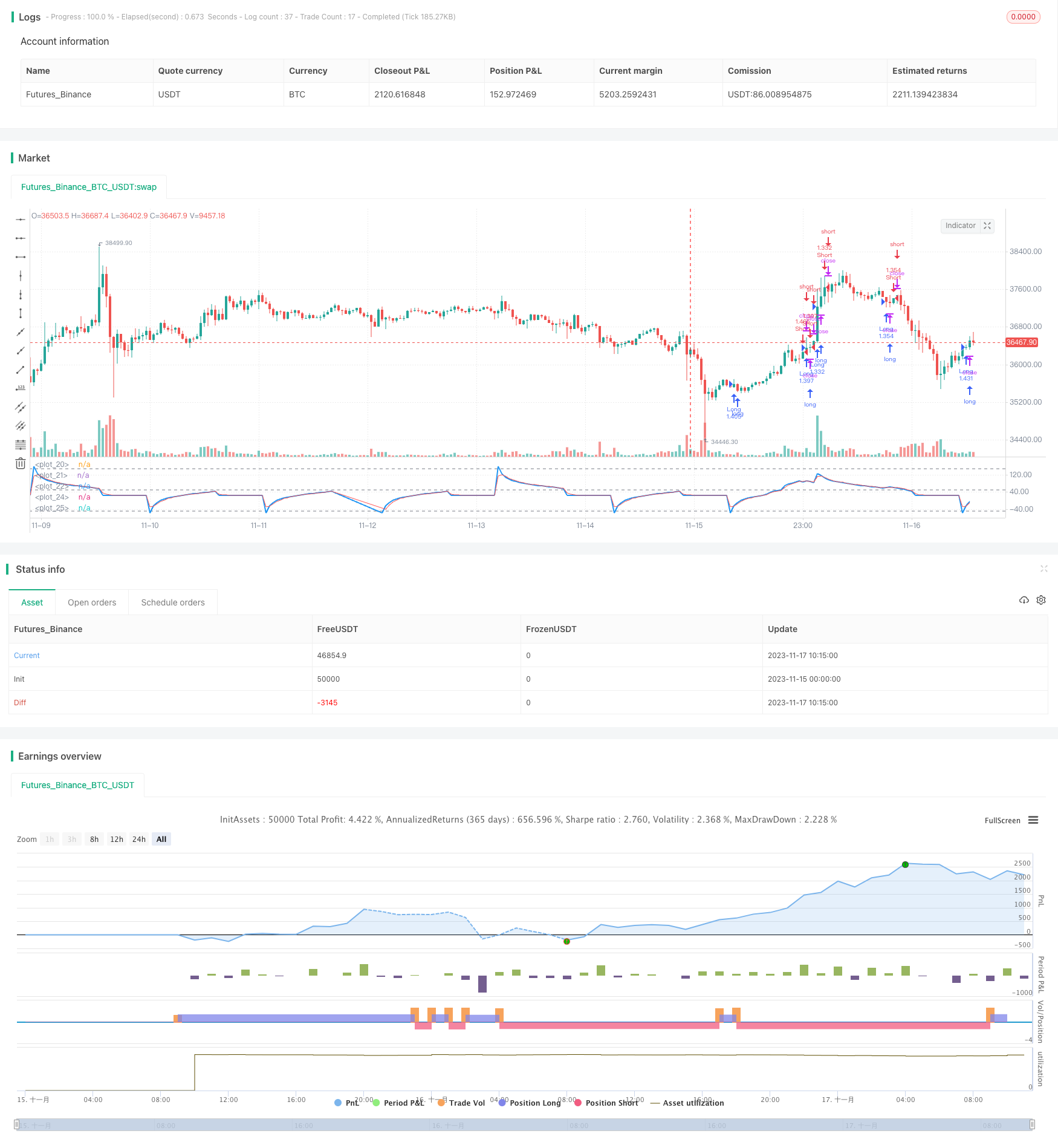
概述
这个策略基于史蒂夫·卡尼什(Steve Karnish)开发的CCT波动带震荡器(CCT Bollinger Band Oscillator)指标,通过识别价格突破均线并结合回撤机制来实现反转交易。
策略原理
该策略使用高价作为源数据,然后计算CCT波动带震荡器的值。震荡器的值在-200到200之间波动,0代表平均价格减去2倍标准差,100代表平均价格加上2倍标准差。当震荡器交叉或下穿其EMA均线时生成交易信号。具体来说,如果震荡器上穿其EMA均线,且两者之间间距大于设定的边际值,则做多;如果震荡器下穿其EMA均线,且两者之间间距小于负的设定边际值,则做空。仓位根据设定的百分比计算。此外,策略还使用回撤止损来止损,根据价格变化的百分比或跳动点数来trailing。
优势分析
- 使用了具有一定市场影响力的CCT波动带震荡器指标,可以减少假信号
- 结合EMA均线和边际条件过滤信号,避免在震荡过程中产生过多无效交易
- 使用回撤止损机制,可以在亏损过大时及时止损
风险分析
- CCT震荡器本身会产生一定的滞后,从而错过价格反转的最佳时间点
- 边际值设置过大和EMA周期设置过短都会增加交易频率和风险
- 回撤止损设置过于宽松会增加亏损风险
风险控制方法:
- 调整EMA均线周期,使用较长周期滤波
- 适当调整边际值以平衡风险和收益
- 降低仓位比例以控制单笔损失
- 适当缩小回撤止损范围,加快止损速度
优化方向
该策略可以从以下几个方面进行优化:
- 更换其他波动指标,如布林带指标、Keltner通道等,判断买卖点
- 增加其他过滤指标,如MACD、RSI等,确保交易信号的可靠性
- 使用机器学习算法自动优化参数,如EMA周期、边际值等
- 增加仓位管理机制,如固定比例仓位、马丁格尔等,控制交易风险
- 优化回撤止损机制,使用波动止损或ATR止损等方式
总结
本策略整体来说是一个基于CCT波动带指标判断价格反转的量化交易策略。它有一定的优势,但也存在改进的空间。通过参数优化、增加过滤指标、使用Feature工程、引入机器学习等方式,可以进一步增强该策略的稳定性和盈利能力。
策略源码
/*backtest
start: 2023-11-15 00:00:00
end: 2023-11-17 11:00:00
period: 45m
basePeriod: 5m
exchanges: [{"eid":"Futures_Binance","currency":"BTC_USDT"}]
*/
//@version=2
// This strategy is based on the CCT Bollinger Band Oscillator (CCTBO)
// developed by Steve Karnish of Cedar Creek Trading and coded by LazyBear.
// Indicator is available here https://www.tradingview.com/v/iA4XGCJW/
strategy("Strategy CCTBBO v2 | Fadior", shorttitle="Strategy CCTBBO v2", pyramiding=0, precision=2, calc_on_order_fills=false, initial_capital=1000, default_qty_type=strategy.percent_of_equity, currency="USD", default_qty_value=100, overlay=false)
length_stddev=input(title="Stddev loopback period",defval=20)
length_ema=input(title="EMA period", defval=2)
margin=input(title="Margin", defval=0, type=float, step=0.1)
price = input(title="Source", defval=high)
digits= input(title="Number of digits",defval=2,step=1,minval=2,maxval=6)
offset = input(title="Trailing offset (0.01 = 1%) :", defval=0.013, type=float, step=0.01)
pips= input(title="Offset in ticks ?",defval=false,type=bool)
src=request.security(syminfo.tickerid, "1440", price)
cctbbo=100 * ( src + 2*stdev( src, length_stddev) - sma( src, length_stddev ) ) / ( 4 * stdev( src, length_stddev ) )
ul=hline(150, color=gray, editable=true)
ll=hline(-50, color=gray)
hline(50, color=gray)
fill(ul,ll, color=green, transp=90)
plot(style=line, series=cctbbo, color=blue, linewidth=2)
plot(ema(cctbbo, length_ema), color=red)
d = digits == 2 ? 100 : digits == 3 ? 1000 : digits == 4 ? 10000 : digits == 5 ? 100000 : digits == 6 ? 1000000 : na
TS = 1
TO = pips ? offset : close*offset*d
CQ = 100
TSP = TS
TOP = (TO > 0) ? TO : na
longCondition = crossover(cctbbo, ema(cctbbo, length_ema)) and cctbbo - ema(cctbbo, length_ema) > margin
if (longCondition)
strategy.entry("Long", strategy.long)
strategy.exit("Close Long", "Long", qty_percent=CQ, trail_points=TSP, trail_offset=TOP)
shortCondition = crossunder(cctbbo, ema(cctbbo, length_ema)) and cctbbo - ema(cctbbo, length_ema) < -margin
if (shortCondition)
strategy.entry("Short", strategy.short)
strategy.exit("Close Short", "Short", qty_percent=CQ, trail_points=TSP, trail_offset=TOP)